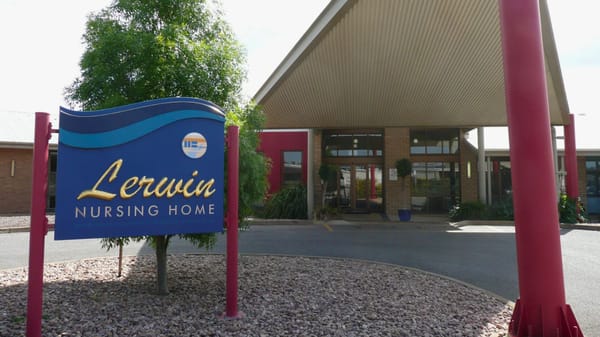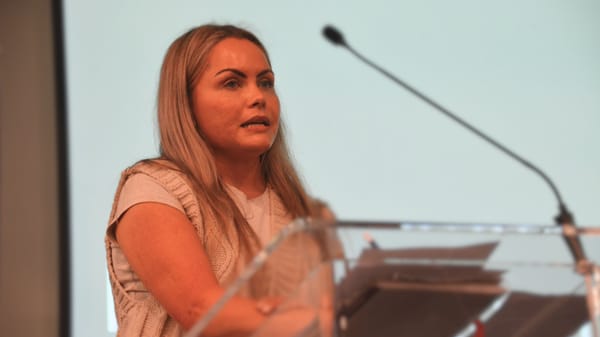Phil Robin’s World War I sacrifice recalled on Remembrance Day 2023 in Murray Bridge
More than a century ago, the life of a national football star and much-loved banker was cut short. This is his story.

Locals support locals – that’s why this recent post is now free to read. Your support can help Murray Bridge News tell important local stories. Subscribe today.

The sacrifice made by a state footballer, banker and original ANZAC has been recalled at a Remembrance Day service in Murray Bridge.
Phil Robin grew up in Adelaide, became a star player at St Peters College during his teenaged years, and soon found himself playing for Norwood and South Australia on tours to Sydney, Melbourne and Perth.
“His electrifying dashes down the wing, weaving and dodging his way past opponents, delighted both the Redleg faithful as well as general connoisseurs of the game,” one sportswriter wrote.
During the week he worked at the Murray Bridge branch of the Bank of Adelaide, initially as a teller, then as an accountant.
“His genial nature and thoughtfulness made him a warm favorite with the bank’s customers in their dealings with him,” manager R. Smeaton would later recall.

Mobilong council chairman John Homburg remembered him as an active citizen.
“There was no worthy effort made by the people of this town with which Mr Robin failed to associate himself,” he would later say.
“As an interstate footballer he became a popular hero; but to those whose good fortune it was to know him intimately, his sterling qualities of character far outshone the transient fame he won as an all-round athlete.”
Life was good, but the times were troubling.
Locals support locals. Your support helps Murray Bridge News tell important local stories.
On August 4, 1914, the United Kingdom and Australia were drawn into the war that was beginning in Europe.
Less than three weeks later – five days after his 30th birthday – Mr Robin “expressed his willingness to surrender his own cherished ideas of life and success for the nation’s life and prosperity”, as The Chronicle would later put it, and enlisted in the Australian Army.
There were moments of joy in the service – several of his footy mates had enlisted alongside him, after all.
He was even able to marry his sweetheart, Nellie Honeywill, in the shadow of the pyramids in Egypt on January 20, 1915.

Then, in April, he was sent to Gallipoli.
Remarkably, he had one more great achievement in him.
On the first day of the Allied assault, the original Anzac Day, he and a Private Arthur Blackburn made it further up the beach and into the hills than any other soldiers.
“He was a brave and gallant soldier,” his commanding officer, Stanley Price Weir, would later write.
“The Turks, who occupied a hill on the beach when we landed, poured their deadly bullets into our boats before we were in water shallow enough to jump out, and it is a wonder any escaped.
“All our trenches had to be dug under heavy fire.
“Their shrapnel is very deadly.”
On April 26, Lance Corporal Robin wrote the last entry in his Little Book for Nellie.
He was killed on April 28, 1915.
Tragically, his wife did not long survive him.
She died in childbirth in London that November, along with their infant son.

Wreaths laid at Remembrance Day service in Murray Bridge
Hospital board chair Greg O’Brien shared a little of Lance Corporal Robin’s story at a Remembrance Day service in Murray Bridge on Saturday, as an example of the sacrifices made for the nation during World War I.
Out of the 35,000 South Australians who enlisted during the conflict, 6000 never came back.
“We owe it to those who gave their lives, the families who mourned them, our generation and our nation’s future to remember the extraordinary service and sacrifice during the First World War, and in the time since,” Mr O’Brien said.
“Today we have men and women deployed around the world, especially in the Middle East and in peacekeeping missions.
“We pray they are kept safe and are returned to us to live long and productive lives.”



About 150 people observed a minute’s silence during the service at Sturt Reserve on Saturday morning.
Representatives of 14 local organisations laid wreaths at the foot of the war memorial there, and RSL president Rod Harris and Lutheran Pastor Paul Calnan gave spoken tributes.
Wreaths were laid at the memorial gates at Murray Bridge Soldiers’ Memorial Hospital, too.
After all, the names etched into the marble deserve not to be forgotten, as Mr Homburg wrote about Lance Corporal Robin 108 years ago.
“In Murray Bridge he has left friends who will always cherish his memory as one of the beautiful experiences of their lives, and when, in the years to come, the Great War is referred to, we shall recall with pride the name of Phil Robin.”
- More information about Phil Robin: Visit vwma.org.au or oa.anu.edu.au.






